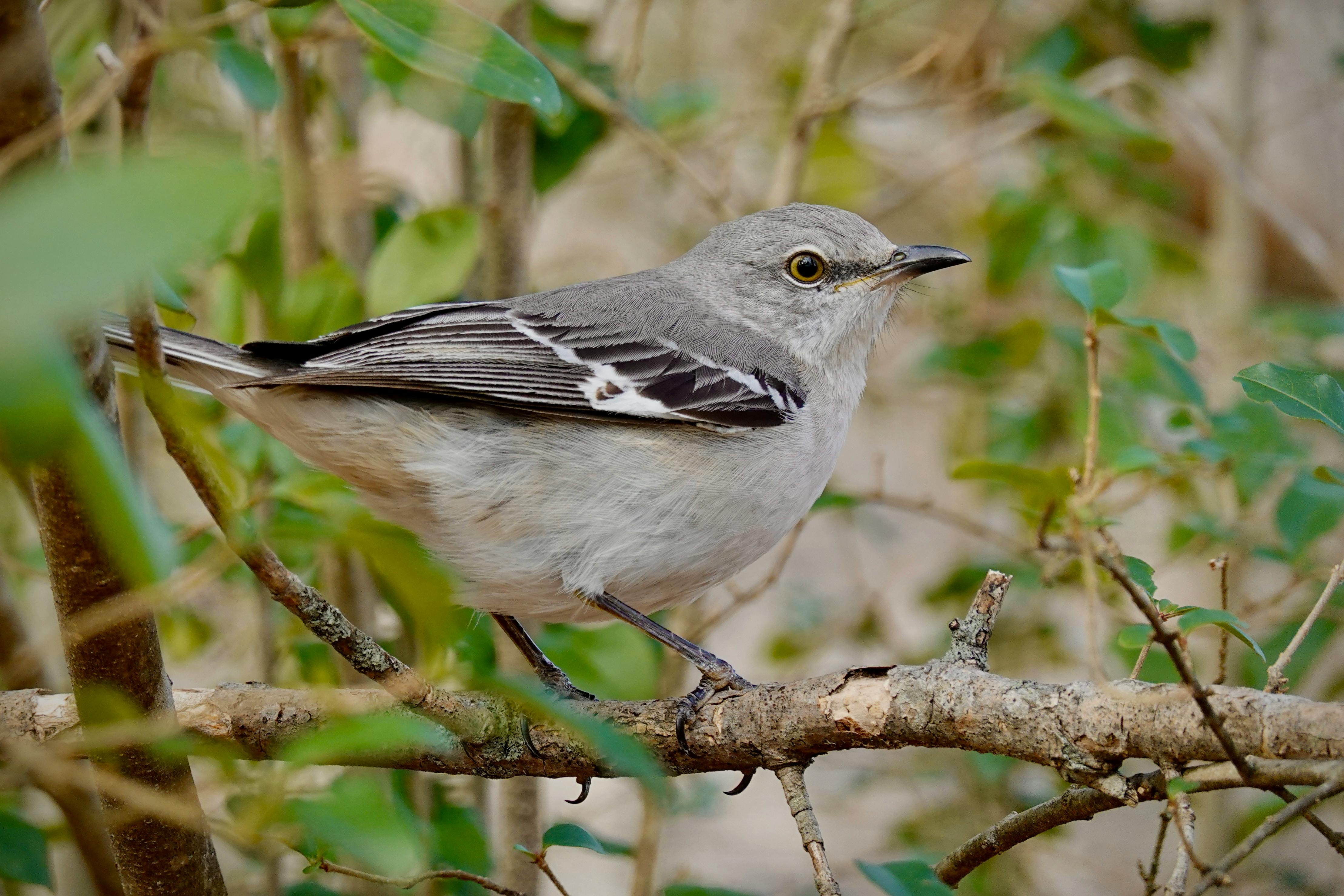Introduction

Arkansas, nestled in the southern region of the United States, boasts a rich natural heritage and diverse geography. From the majestic Ozark Mountains to the fertile Arkansas Delta and the flowing waters of the Mississippi River, this state offers a remarkable tapestry of landscapes. Its official state bird, the Northern Mockingbird (Mimus polyglottos), symbolizes its unique identity and natural abundance.
With its grayish-brown plumage and striking white underparts, the Northern Mockingbird stands out. During flight, its prominent white wing patches add elegance to its appearance. What truly sets this bird apart is its unparalleled talent for mimicking the sounds of other birds and even non-avian species. Its melodious repertoire echoes throughout Arkansas, providing a memorable auditory experience.
The Northern Mockingbird holds the distinction of being the state bird in four other U.S. states: Florida, Mississippi, Tennessee, and Texas. This widespread recognition further reinforces its significance and appeal.
History of Arkansas’ State Bird
![]()
The Northern Mockingbird became the state bird of Arkansas on March 11, 1929, designated by the Arkansas General Assembly. The Arkansas Federation of Women’s Clubs played a pivotal role in initiating the campaign to select the state bird. A statewide ballot allowed citizens to vote for their preferred bird, and the Northern Mockingbird quickly emerged as the popular choice.
Its melodious song, which captured the hearts and minds of Arkansans, along with its ability to mimic other birds and even human sounds, contributed to its widespread appeal. The bird’s adaptability and resilience, thriving in both rural and urban areas, made it an ideal representative of Arkansas’s avian fauna.
The Northern Mockingbird’s selection as the state bird solidified its status as a cherished symbol of Arkansas’s natural beauty and cultural identity. It is celebrated in various cultural and artistic expressions, serving as a testament to its importance in symbolizing the state’s unique identity and rich natural heritage.
The historical journey that led to the recognition of the Northern Mockingbird showcases the commitment of Arkansas’s citizens to honoring and preserving the state’s natural treasures. The next section will delve into a detailed description of the physical characteristics, habitat, and behavior of the Arkansas state bird, shedding light on its captivating attributes.
Description of the Arkansas State Bird
![]()


The Arkansas State Bird is the Northern Mockingbird (Mimus polyglottos), a charming and versatile songbird that adds melodious beauty to the state’s natural landscape. Let’s delve into its physical characteristics, habitat, behavior, and unique features.
Physical Characteristics
The Northern Mockingbird is a medium-sized songbird, measuring approximately 8-11 inches in length. Its captivating plumage boasts grayish-brown tones with distinctive white patches on the wings, a white belly, and prominent white wing bars. During flight, the bird reveals its elegant long tail adorned with white outer feathers. With a slender body, slightly curved beak, and dark eyes, this avian wonder is truly a sight to behold.
Habitat
The Northern Mockingbird gracefully adapts to various environments, including urban areas, suburban gardens, forests, and shrublands. It particularly favors open spaces with scattered trees and shrubs, such as parks, gardens, and woodland edges. However, it can also be found in coastal areas, farmlands, and grasslands, showcasing its remarkable adaptability and widespread presence within Arkansas.
Behavior
![]()
Renowned for its exceptional singing ability, the Northern Mockingbird effortlessly mimics the sounds of other birds, insects, and even human noises. Males utilize their singing prowess during the breeding season, employing a variety of tunes to establish territory and attract potential mates. These captivating performances fill the air with a symphony of enchanting melodies.
In addition to its musical talents, the Northern Mockingbird exhibits strong territorial behavior, vigorously defending its nesting areas against intruders. This protective instinct ensures the safety and well-being of its offspring.
Unique Features
The Northern Mockingbird’s remarkable vocal dexterity allows it to mimic a wide range of sounds, captivating listeners with its versatile abilities. Its adaptability to diverse habitats sets it apart, showcasing its resilience and versatility as a species. These unique features contribute to the widespread distribution of the Northern Mockingbird throughout Arkansas, establishing it as an iconic symbol of the state’s avian diversity.
The captivating Northern Mockingbird, with its alluring appearance, enchanting songs, and remarkable adaptability, rightfully claims its place as the beloved state bird of Arkansas. Its presence serves as a reminder of the beauty and wonders found within the state’s natural landscape.
Why the Arkansas State Bird Was Selected


The selection of the Northern Mockingbird as the official state bird of Arkansas was based on several factors:
Abundance and Distribution
The Northern Mockingbird is a common bird found throughout Arkansas, making it easily recognizable and familiar to residents. Its widespread presence played a significant role in its selection as the state bird.
Vocal Abilities

The Northern Mockingbird’s exceptional ability to mimic the songs of other birds and sounds from the environment adds to its appeal. Its melodious and diverse repertoire of songs captivates birdwatchers and nature enthusiasts alike, making it a fitting choice as the state bird.
Resilience and Adaptability
The Northern Mockingbird‘s ability to thrive in various habitats, including urban and rural landscapes, reflects the spirit and resilience of the people of Arkansas. Its adaptability and tenacity contributed to its selection as the state bird.
Symbolic Representation
Mockingbirds are known for their protective nature, fearlessly defending their territories. By selecting the Northern Mockingbird, Arkansas honored the values of bravery and protection, symbolizing the courage and protectiveness of its people.
Historical and Cultural Significance
The Northern Mockingbird has deep roots in American literature, folklore, and music. Its portrayal in works like Harper Lee’s “To Kill a Mockingbird” solidifies its cultural significance. The association of the Northern Mockingbird with American heritage contributed to its selection as the state bird of Arkansas.
In conclusion, the selection of the Northern Mockingbird as the official state bird of Arkansas was influenced by its abundance and distribution, remarkable vocal abilities, resilience and adaptability, symbolic representation of courage and protectiveness, and historical and cultural significance. These factors collectively made the Northern Mockingbird a fitting representative of the state and its people, ultimately leading to its designation as the Arkansas state bird.
Description of the Arkansas State Bird
The Northern Mockingbird (Mimus polyglottos) was designated as the official state bird of Arkansas in 1929. This captivating medium-sized songbird is known for its distinctive physical characteristics, habitat preferences, and fascinating behavior.
Physical Characteristics
The Northern Mockingbird measures approximately 9 to 11 inches in length and has a slender build with long, graceful wings. Its predominantly gray plumage is complemented by pale undersides and white wing patches that become visible during flight. Notably, its expressive eyes are a vibrant yellow color.
Habitat and Behavior

Highly adaptable, the Northern Mockingbird can be found in various habitats throughout Arkansas, including urban areas, woodlands, scrublands, and gardens. This avian species is a year-round resident, with stable populations across the state.
Known for their exceptional vocal abilities, Northern Mockingbirds possess the remarkable talent of mimicking the sounds of other birds and imitating various sounds, such as car alarms and sirens. Their melodious songs serve multiple purposes, including attracting mates, establishing territories, and warding off potential threats.
Nesting Habits
Meticulous nest builders, Northern Mockingbirds construct cup-shaped nests made of twigs, grass, and other plant materials. They prefer dense shrubs or trees as nesting sites, providing protection and camouflage for their offspring. Females take primary responsibility for nest building, while males actively defend the nesting territory.
Reproduction and Parental Care
During the breeding season, which typically occurs from April to August, female Northern Mockingbirds lay clutches of 2 to 6 eggs. Both parents share the incubation duties, which last approximately 12 to 13 days. Once hatched, the young birds remain in the nest for about 11 to 14 days, during which time they are cared for and fed by their devoted parents. After leaving the nest, the fledglings continue to receive parental guidance until they become independent.
Other Fascinating Facts

- The Northern Mockingbird’s diet consists primarily of insects, berries, fruits, and seeds, allowing them to thrive in various environments.
- Skillful hunters and foragers, these birds search for food on the ground or in low shrubs and trees, using their keen eyesight and agile movements.
- Northern Mockingbirds are known for their territorial behavior, defending their nesting sites against potential threats and intruders.
- The species exhibits remarkable intelligence and memory, recognizing individual humans and displaying aggressive behavior towards perceived threats.
- The Northern Mockingbird’s diverse repertoire of songs can consist of hundreds of different phrases, each repeated several times before transitioning to a new melody.
The unique characteristics, versatile adaptation, and captivating behavior of the Northern Mockingbird make it a cherished and iconic symbol of Arkansas’s avian heritage.
Description of the Arkansas State Bird
The Northern Mockingbird (Mimus polyglottos) is the official state bird of Arkansas. This medium-sized songbird is known for its remarkable vocal abilities and mimicry, making it a common and captivating sight throughout the state.
Physical Characteristics
With its slender body, grayish-brown feathers on the upperparts, and a whitish underbelly, the Northern Mockingbird displays an elegant appearance. During flight, its long wings and distinctive tail with white patches are prominently showcased. The bird’s slightly curved black beak enables efficient feeding on a diverse diet.
Habitat and Behavior
Adaptable and versatile, Northern Mockingbirds can be found in various habitats across Arkansas, including urban areas, forests, parks, gardens, and farmlands. They fiercely defend their chosen nesting sites, showcasing their territorial nature. Renowned for their remarkable singing abilities, these birds produce a complex and melodious song repertoire that includes mimicry of other bird species and even sounds from the environment, such as car alarms or cell phone ringtones. Foraging on the ground and in low vegetation, they rely on their sharp eyesight to spot prey, which ranges from insects and berries to fruits, seeds, and occasionally small reptiles or amphibians.
Why the Arkansas State Bird Was Selected
The selection of the Northern Mockingbird as Arkansas’ official state bird was influenced by several significant factors.
Cultural Significance
The Northern Mockingbird holds a special place in the hearts of Arkansans due to its melodious songs and vibrant presence in both rural and urban environments. Its distinctive vocalizations have come to symbolize the state’s natural beauty and rich biodiversity.
Abundance and Resilience
The Northern Mockingbird’s widespread distribution and stable population in Arkansas played a significant role in its selection. This bird’s adaptability to various habitats and its ability to thrive in both rural and urban settings demonstrate its resilience and capacity to coexist harmoniously with humans.
Representation of Arkansas’ Spirit
The Northern Mockingbird embodies the spirit of Arkansas through its resourcefulness, versatility, and ability to adapt to changing circumstances. These characteristics align with the state’s values of perseverance, resilience, and a willingness to embrace new challenges.
Interesting Facts About the Arkansas State Bird

Discover some intriguing facts about the Northern Mockingbird, Arkansas’ state bird:
-
Vocal Virtuosity: The Northern Mockingbird is known for its astonishing vocal range, capable of mimicking the songs of over 200 different bird species, as well as various sounds from its environment.
-
Nighttime Serenades: Male Northern Mockingbirds often sing during the night to defend their territory and attract mates. Their nocturnal performances can be heard during the breeding season.
-
Fearless Defenders: Northern Mockingbirds fearlessly confront larger birds or animals that approach their territory, even engaging in aerial displays to deter potential threats. They fiercely protect their nests.
-
State Bird of Multiple States: In addition to Arkansas, the Northern Mockingbird also holds the distinction of being the official state bird of Florida, Mississippi, Tennessee, and Texas.
-
Lifespan: These remarkable birds have been known to live up to 8 to 10 years in the wild, with some individuals reaching even longer lifespans.
Conservation Status of the Arkansas State Bird

The Northern Mockingbird population in Arkansas is considered stable, with no major concerns regarding its overall numbers. However, ongoing conservation efforts are essential to ensure the bird’s long-term survival and maintain its population levels.
Conservation Efforts
Several organizations and initiatives in Arkansas actively work to protect the Northern Mockingbird and its habitat. Local birdwatching clubs, wildlife agencies, and conservation non-governmental organizations (NGOs) engage in educational programs, habitat restoration projects, and citizen science initiatives to monitor the species’ population trends and distribution.
Importance of Habitat Conservation
Habitat conservation plays a crucial role in ensuring the well-being of the Northern Mockingbird. Preserving diverse habitats, including forests, parks, and green spaces, is essential to provide suitable foraging areas, nesting sites, and shelter. By protecting these habitats, we ensure the availability of resources necessary for the Northern Mockingbird’s survival.
Threats
While the Northern Mockingbird population in Arkansas remains stable, potential threats to their well-being persist. Habitat loss due to urbanization, agricultural expansion, and deforestation can fragment and degrade their habitats. Pesticide use may also impact the availability of their prey. Additionally, predation by domestic cats poses a significant threat to nesting birds, including the Northern Mockingbird.
Citizen Science and Monitoring
Citizen science and monitoring programs play a vital role in tracking the population trends and distribution of Northern Mockingbirds in Arkansas. Public participation through birdwatching activities, data collection, and reporting sightings contributes to our understanding of their status and informs conservation efforts.
Continued efforts to protect the Northern Mockingbird and its habitat ensure that future generations in Arkansas will have the chance to enjoy the bird’s melodious songs and appreciate its remarkable adaptability.
Conclusion

This blog post offers a comprehensive overview of the Arkansas state bird and emphasizes the importance of protecting this remarkable species.
Recap of the main points: Throughout the article, we explored the historical background, physical characteristics, habitat, behavior, and unique features of the [insert name of the state bird]. This [describe the bird] is known for its [mention unique features].
Ecological significance: The Arkansas state bird plays a vital role within the ecosystem, contributing to the balance and health of the local environment. Whether as a predator or pollinator, it impacts the ecosystem’s dynamics.
Conservation efforts: Protecting the Arkansas state bird and its habitat is crucial. Several conservation initiatives and organizations actively work towards preserving this species. However, habitat loss, climate change, and pollution pose significant threats to its survival and overall population.
Public awareness and involvement: Public awareness and involvement are key to safeguarding the Arkansas state bird. By educating ourselves and others about its conservation status, we promote a greater appreciation for its significance and the need for protection. Supporting local conservation organizations, participating in citizen science projects, and advocating for habitat preservation are ways individuals can contribute to its preservation.
In conclusion, the Arkansas state bird represents the natural beauty of the state and the delicate balance of its ecosystem. Prioritizing its protection ensures the preservation of a unique species and a healthy environment for future generations.
Remember, our collective efforts are essential in safeguarding the Arkansas state bird and its habitat. Let us join hands to celebrate and protect this remarkable creature, ensuring its survival and the continued ecological vitality of Arkansas.
Frequently Asked Questions
What is the Arkansas state bird?
The Arkansas state bird is the Northern Mockingbird (Mimus polyglottos). It was designated as the official state bird of Arkansas in 1929.
Why was the Northern Mockingbird chosen as the Arkansas state bird?
The Northern Mockingbird was chosen as the Arkansas state bird due to its abundance and distribution throughout the state, its exceptional vocal abilities and mimicry, its resilience and adaptability to various habitats, its representation of Arkansas’s spirit and values, and its historical and cultural significance.
What are the physical characteristics of the Northern Mockingbird?
The Northern Mockingbird is a medium-sized songbird measuring approximately 9 to 11 inches in length. It has grayish-brown feathers on the upperparts, a whitish underbelly, and distinctive white wing patches. During flight, its long wings and tail with white patches are prominently displayed. The bird has a slender body, a slightly curved black beak, and vibrant yellow eyes.
Where can the Northern Mockingbird be found in Arkansas?
The Northern Mockingbird can be found in various habitats throughout Arkansas, including urban areas, forests, parks, gardens, and farmlands. It is a year-round resident and has stable populations across the state.
How does the Northern Mockingbird mimic other birds and sounds?
The Northern Mockingbird has exceptional vocal abilities and can mimic the songs of over 200 different bird species, as well as various sounds from its environment, such as car alarms and sirens. It uses its melodious and diverse repertoire of songs for various purposes, including attracting mates, establishing territories, and warding off potential threats.

Leave a Reply